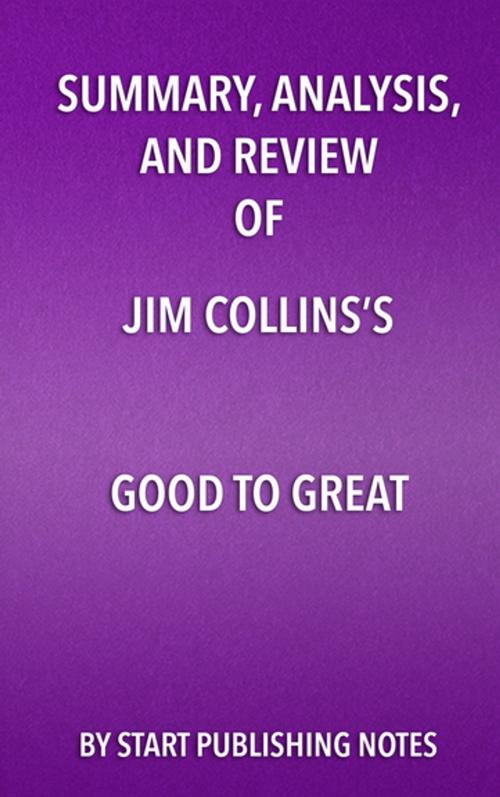Summary, Analysis, and Review of Jim Collins’s Good to Great
Why Some Companies Make the Leap... and Others Don’t
Nonfiction, Reference & Language, Study Aids| Author: | Start Publishing Notes | ISBN: | 9781682996706 |
| Publisher: | Start Publishing Notes | Publication: | May 22, 2017 |
| Imprint: | Start Publishing Notes | Language: | English |
| Author: | Start Publishing Notes |
| ISBN: | 9781682996706 |
| Publisher: | Start Publishing Notes |
| Publication: | May 22, 2017 |
| Imprint: | Start Publishing Notes |
| Language: | English |
PLEASE NOTE: This is a key takeaways and analysis of the book and NOT the original book.
Start Publishing Notes’ Summary, Analysis, and Review of Jim Collins’s Good to Great: Why Some Companies Make the Leap... and Others Don’t includes:
In Good to Great: Why Some Companies Make the Leap...and Others Don’t, Jim Collins posits that most American entities (from the federal government and multi-national corporations all the way down to individuals) are hindered by being good, and thus not rising to being great. “That good is the enemy of great is not just a business problem,” he writes. “It is a human problem”(16). As such, the question naturally arises: Can a good enough government, company, organization, or person become a great one? If so, is there a discrete methodology that might consistently yield a transformation form good to great? “Or is the disease of ‘just being good’ incurable?”(5).
To answer this question, Collins and his team executed a massive research project (spanning five years and totaling a combined 15,000 hours of research for its twenty-one-person team). Rather than beginning with a hypothesis and drilling down for confirmation or falsification, Collins and his team started by collecting, coding, and analyzing raw data and existing writing and research. From there they worked their way up to a set of core practices among organizations that move from good to great, ultimately working up a linear roadmap any organization can follow to make such a transformation.
Start Publishing Notes’ Summary, Analysis, and Review of Jim Collins’s Good to Great: Why Some Companies Make the Leap... and Others Don’t includes:
- Summary of the book
- A Review
- Analysis & Key Takeaways
- A detailed “About the Author” section
In Good to Great: Why Some Companies Make the Leap...and Others Don’t, Jim Collins posits that most American entities (from the federal government and multi-national corporations all the way down to individuals) are hindered by being good, and thus not rising to being great. “That good is the enemy of great is not just a business problem,” he writes. “It is a human problem”(16). As such, the question naturally arises: Can a good enough government, company, organization, or person become a great one? If so, is there a discrete methodology that might consistently yield a transformation form good to great? “Or is the disease of ‘just being good’ incurable?”(5).
To answer this question, Collins and his team executed a massive research project (spanning five years and totaling a combined 15,000 hours of research for its twenty-one-person team). Rather than beginning with a hypothesis and drilling down for confirmation or falsification, Collins and his team started by collecting, coding, and analyzing raw data and existing writing and research. From there they worked their way up to a set of core practices among organizations that move from good to great, ultimately working up a linear roadmap any organization can follow to make such a transformation.
PLEASE NOTE: This is a key takeaways and analysis of the book and NOT the original book.
Start Publishing Notes’ Summary, Analysis, and Review of Jim Collins’s Good to Great: Why Some Companies Make the Leap... and Others Don’t includes:
In Good to Great: Why Some Companies Make the Leap...and Others Don’t, Jim Collins posits that most American entities (from the federal government and multi-national corporations all the way down to individuals) are hindered by being good, and thus not rising to being great. “That good is the enemy of great is not just a business problem,” he writes. “It is a human problem”(16). As such, the question naturally arises: Can a good enough government, company, organization, or person become a great one? If so, is there a discrete methodology that might consistently yield a transformation form good to great? “Or is the disease of ‘just being good’ incurable?”(5).
To answer this question, Collins and his team executed a massive research project (spanning five years and totaling a combined 15,000 hours of research for its twenty-one-person team). Rather than beginning with a hypothesis and drilling down for confirmation or falsification, Collins and his team started by collecting, coding, and analyzing raw data and existing writing and research. From there they worked their way up to a set of core practices among organizations that move from good to great, ultimately working up a linear roadmap any organization can follow to make such a transformation.
Start Publishing Notes’ Summary, Analysis, and Review of Jim Collins’s Good to Great: Why Some Companies Make the Leap... and Others Don’t includes:
- Summary of the book
- A Review
- Analysis & Key Takeaways
- A detailed “About the Author” section
In Good to Great: Why Some Companies Make the Leap...and Others Don’t, Jim Collins posits that most American entities (from the federal government and multi-national corporations all the way down to individuals) are hindered by being good, and thus not rising to being great. “That good is the enemy of great is not just a business problem,” he writes. “It is a human problem”(16). As such, the question naturally arises: Can a good enough government, company, organization, or person become a great one? If so, is there a discrete methodology that might consistently yield a transformation form good to great? “Or is the disease of ‘just being good’ incurable?”(5).
To answer this question, Collins and his team executed a massive research project (spanning five years and totaling a combined 15,000 hours of research for its twenty-one-person team). Rather than beginning with a hypothesis and drilling down for confirmation or falsification, Collins and his team started by collecting, coding, and analyzing raw data and existing writing and research. From there they worked their way up to a set of core practices among organizations that move from good to great, ultimately working up a linear roadmap any organization can follow to make such a transformation.















